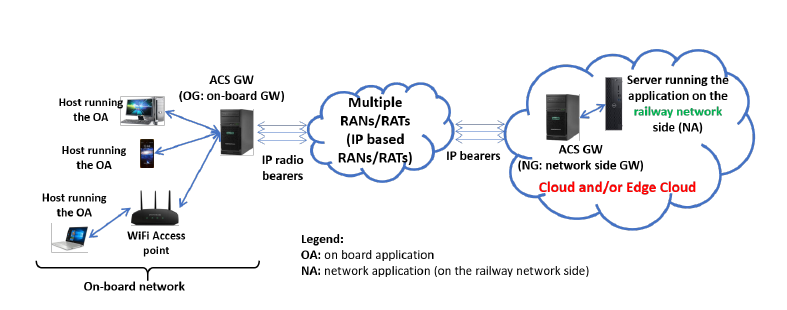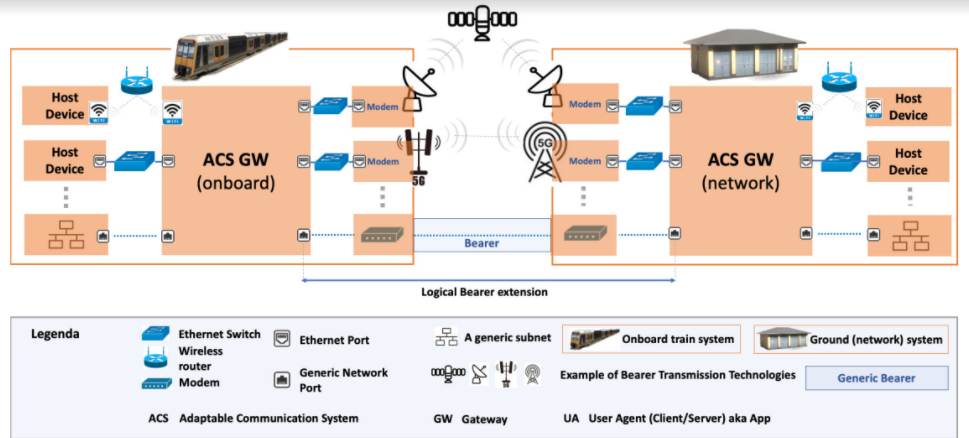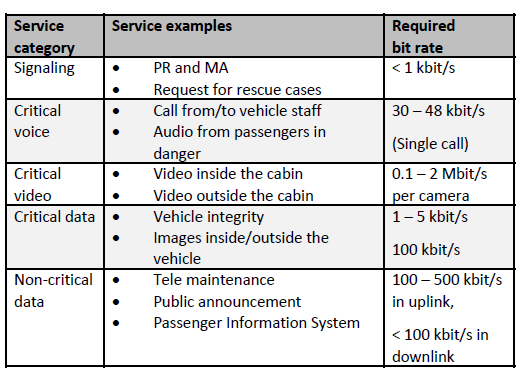Adaptable Communication System (ACS) for Flexible Communications in the Transport Sector: the AB4Rail project experience
R. Giuliano, F. Mazzenga, A. V. Vegni, A. Vizzarri,, 2021 AEIT International Conference on Electrical and Electronic Technologies for Automotive (2021 AEIT AUTOMOTIVE), Virtual Conference, Nov. 2021

The introduction of GSM-R as a mandatory radio communication system for operational voice and ERTMS/ETCS data communication between rail infrastructure and the train on- board systems has provided a stable pillar for the single European railway area, based on a single radio technology and a single radio spectrum band. In recent years, it has however become clear that placing sole reliance on a single radio technology that is shortly becoming obsolescent is not a viable approach going forward. A more flexible approach is needed for the future based on multi communication technologies. The paper summarizes the characteristics of the adaptable communication system (ACS) technology developed in the railway context as a baseline for the spread of future railway communication system. We outline the application of ACS to other transport sectors such as the automotive one, allowing to introduce a novel and flexible vision of V2X communications based on the abstraction of the underlying communication technologies and on the creation of an overlay mesh-based adaptable communication platform above which applications can negotiate QoS parameters and exchange data without worrying of connectivity aspects including setup/maintenance and drop of connections. Finally, the possibility for ACS to create heterogeneous access network is also discussed.
Emulation of Rail and Automotive Applications based on Adaptable Communication System
A. Calderone, R. Giuliano, 2021 AEIT International Conference on Electrical and Electronic Technologies for Automotive (2021 AEIT AUTOMOTIVE), Virtual Conference, Nov. 2021

Communication requirements of railway operators for different types of services, including voice, video, railway signalling, data transmission are growing fast. As such requirements on railway communications evolve, there is a need to move towards new telecommunication technologies. The European Railways Train Management System (ERTMS) utilizes the Global System for Mobile Communications – Railway (GSM-R) as the legacy telecommunication network connecting trains with the ground. Such technology is to be substituted since it cannot satisfy an increasing demand of connectivity for new railway applications. Shift2Rail partners have agreed on adopting the Adaptable Communication System (ACS) as the reference system architecture for implementing the successor of the GSM-R. This paper proposes an ACS model along with its implementation, based on solution, which relies on internet protocol suite as an alternative to the deployment of a dedicated network infrastructure. Test results presented and discussed in this article have been used to assess the performance and effectiveness of the proposed solution. Finally, the paper also proposes an extension of the ACS concept from the rail sector to the automotive sector.
CNN-based Passenger Detector for Public Transport Vehicles
E. Innocenti, R. Giuliano, 2021 AEIT International Conference on Electrical and Electronic Technologies for Automotive (2021 AEIT AUTOMOTIVE), Virtual Conference, Nov. 2021

Autonomous vehicle technology is becoming relevant not only for researchers but for industries as well. Many studies focus on autonomous cars as primary importance. The growing amount of research enables to improve the economy, safety and the environment. In this paper we want to give attention to the public transport system, more precisely to the bus and train systems. Our study is about the computer vision system and its integration into these vehicles with the aim to recognize passengers waiting at the bus stops or train stations. In particular, the network proposed follows the keypoint estimation approach, which uses a feature extraction backbone in order to generate a low resolution heatmap and, after detecting the peaks on it, regresses to the bounding box sizes and positions. The experimental results achieved an F-Score (β = 2) value of 86% using a ResNet50 backbone.
“Communication Transport Protocol Strategies for Rail Applications”
R. Giuliano, A. Vizzarri, A. Calderone, F. Mazzenga, Applied Sciences 2022, 12(6), 3013; 16 March 2022.
https://doi.org/10.3390/app12063013
The paper analyzes the communication transport protocols for communications between the train and the control center for the management of train traffic. Results show the ability of the Euroradio protocol to perform in the case of wireless transmission channels with delays up to 250ms and with packet losses, when using the Adaptable Communication System architecture.
The full paper is available at: https://lnkd.in/en395Kw2
“Future Technologies for Train Communication: The Role of LEO HTS Satellites in the Adaptable Communication System”
A. Vizzarri, F. Mazzenga and R. Giuliano, Sensors 2023, Vol. 23, Is. 1, 68; Dec. 2022.
https://doi.org/10.3390/s23010068
The new High Throughput Satellite (HTS) Low-Earth Orbit (LEO) constellations promise very interesting performances from data rate and coverage points of view. The paper analyzes the LEO constellations of Starlink and OneWeb using public data and applied to the Rome–Florence railway line. The results show the LEO satellite can provide interesting performance in terms of visibility, service connectivity, and traffic capacities (up to 1 Gbps), enabling the LEO to fully manage a high amount of data, especially in the railway scenarios of the next years when video data applications will be more present.
